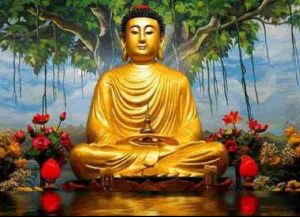Editor’s note: This poem was first published in the now-retired Bodhi Journal, Issue 8, June 2008.
It is a general assumption of the most scholars that the Emptiness Theory of N?g?rjuna is a kind of revolution against the ?bhidharmik?s who tried to explain the true teaching of the Buddha in terms of metaphysical existing entity called Svabh?va. The emptiness theory of N?g?rjuna is said to be based upon the Prajñ?p?ramita scripture. In the MMK [M?lamadhyamakak?rik?] – the significant work of N?g?rjuna – he, taking no particular position and basing on the theory of emptiness, refuted all his opponents and established the true doctrine of the Buddha.
In point of fact, the concept of ??nyat? is not totally a new creation of N?g?rjuna, but it was employed by him to refute the opponent’s views and establish the Buddhadharma. There are discussions of emptiness even in early Buddhist teaching. The C?lasuñña sutta of Sa?yutta Nik?ya is one of examples of this category.
Although the English rendering of the term ‘’S?nyat?’ – i.e. ‘Emptiness’ generally gives a negative impression but it does not mean utter negation. In verses eighteen and nineteen of the chapter twenty four, N?g?rjuna emphatically explains what ??nyat?’ actually is. In these two verses he said that the dependent origination [prat?tyasam?dp?da] is another name for ??nyat? and this is based upon convention (Ya?prat?tyasamutp?da???nyat?? ta? pracak?mahe). And there is nothing whatsoever that is not dependent and hence non empty. So, what Venerable N?g?rjuna is trying to tell us here is that – “in as much as beings dependently co-arise they are empty in their nature.” And this dependent co-arising he explains with the four pairs of eight negations in the dedicatory verse of the MMK. The four pairs of eight negations are: 1) non-ceasing [anirodha?] and non-arising [anutp?da?], 2) non-annihilation [anuccheda?] and non-permanence [a???vata?], 3) non-identity [anek?rtha?] and non-difference [an?n?rtha?] and 4) non-appearance [an?gama?] and non-disappearance [anirgama?].
According to him, one is not evident without the other. They are dependently co-arisen. Hence, they are devoid of intrinsic natures. And something that is dependently co-arisen is constantly arising and passing away. So, they can not be called either existence or non-existence. And that is because ‘existence ’ is contrary to perishing just like ‘non-existence ’ is contrary to arising of things.
Buddhism, in general, talks about two truths namely: 1) conventional truth [sa?v?ti satya] and 2) ultimate truth [param?rtha satya]. N?g?rjuna is of no difference. According to the early Buddhist teaching, names and forms are the conventional truth; in the Madhyamaka also, words and ideas are significantly negated as they are merely conventional truth. On the contrary, the ultimate truth is beyond thought and language. This is why the Buddha always remained in his noble silence when he was asked on the metaphysical matters. The ultimate Truth is ineffable – it is said by the Buddha that he had never preached a single word in his forty five years of preaching life. But the question remains as to why people like the Buddha and N?g?rjuna had used ordinary words and logics and developed a dialectical reasoning in their explanation of the dharma? The answer is to awake people to the truth of emptiness. Because without depending upon the conventional truth, the ultimate can not be expressed.
According to Madhyamaka, the immediate insight into emptiness which is Prajñ? helps sentient beings understand the real nature of things but for Sarv?stiv?dins, it is the investigation of dharmas [dharmapravicaya]. Thus, the definition of Prajñ?,which is wisdom in English, varied from school to school. Not only the definition ofPrajñ? that is varied from school to school but also the so called ultimate reality or true nature of phenomenal world. So, there can be seen different approaches of different schools to the explanation of what is meant by reality.
The most well known dialectical method used by N?g?rjuna in his MMK to explain the reality is the tetralemma [ca?usko?i]: being, non-being, both being and non-being and neither being and nor non-being. This is a formula which includes all possible cases in its scope. Basing on emptiness, he used these four-fold methodology to refute the opponents. Thus he says in verses eight and nine of the chapter four: if analysis or explanation is made based on emptiness, there would be no problem in reputing other’s views. So, here he uses ??nyat? as a tool to refute other’s views.
According to N?g?rjuna, ??nyat? is also a practice for removing views. Any view is substantial because it binds us in the Sa?s?ra. So, where there is view, there is the need of ??nyat?, but if there is no view then there is no need of ??nyat?. According to Gadjin M Nagao; “Emptiness has no standpoint of its own, its standpoint is the standpoint of no standpoint, so to speak.” Moreover, it was asked by Ven. N?g?rjuna not to hold emptiness wrongly for the holder may be affected by it.
In the chapter thirteen, N?g?rjuna says emptiness is to be used when there is something non-empty, but if something is already empty, there is then no need of emptiness anymore. Emptiness is also not to be understood as permanent existence, because holding emptiness as a real entity is also a kind of view which was rejected by N?g?rjuna and hence we see the theory – “emptiness of emptiness.”
In chapter twenty four, it is said that by perceiving dependent co-arising i.e. emptiness – the four noble truths are also perceived. Therefore, it is said that emptiness is the relinquishing of all views. And in chapter eighteen again, emptiness is explained as dharmat? because it is the nature of all things that they are dependently co-arisen and hence intrinsically calm.
N?g?rjuna’s Emptiness doctrine, as we have observed so far, is a doctrine that came down from the Buddha himself. It was used by N?g?rjuna as a tool to refute the opponents, to explain the true nature of phenomenal existence, as the middle way to reach the state of perfect peace. The emptiness idea of N?g?rjuna is actually another name for dependent origination which is equal to the Buddha himself. The statement given by the Buddha is – whosoever sees the dependent arising sees him. That is why we see N?g?rjuna explaining the emptiness as the tatthat?, dharmat? or suchness.
References:
1. Kalupahana, David J. M?lamadhyamakak?rik? of N?g?rjuna [the philosophy of the middle way]. Delhi: Motilal Banrasidass Publishers Private Limited, 1991.
2. Kalupahana, David J. A History of Buddhist Philosophy [Continuities and Discontinuity]. Delhi: Motilal Banrasidass Publishers Private Limited, 1994.
3. Nagao, Gadjin M. M?dhyamika and Yogacara [a study of Mahayana philosophies]. Edited and Translated by Leslie S. Kawamura. Delhi: Sri Satguru Publication, 1992.
4. Thomas, Edward J. The History of Buddhist Thought. Delhi: Munshiram Monoharlal Publishers Pvt. Ltd., 1933.
5. Inada, Kenneth. N?g?rjuna: a Translation of its M?lamadhyamakak?rik? with an Introductory Essay. Delhi: Sri Satguru, 1993.
You can access the original Bodhi Journal articles in our archive.












